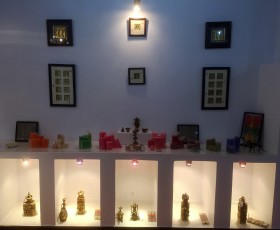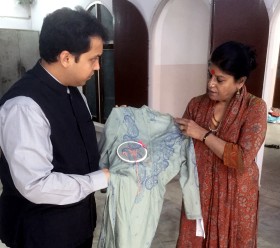By Kundan Madireddy, Project Manager and Dr. Shashank Shah, Project Director
On February 19th, the Harvard University South Asia Institute and Tata Trusts hosted the third of a multi-part series of webinars on Rural Livelihoods Creation in the Indian Handicrafts and Handloom sectors. Led by Dr. Vandana Bhandari, Professor and Dean (Academics) at the National Institute of Fashion Technology, New Delhi, this webinar provided an overview to the techniques and best practices in Handicrafts documentation.
India has a rich and diverse cultural and crafts heritage. It is important to safeguard and document this to make it accessible to the present and future generations. Crafts play a unique role in nurturing the cultural diversity of India, and at the same time aid in employment growth and income generation for India.
Fashion in India is largely inspired by the rich legacy of textiles that have flourished here for many millennia. A combination of contemporary and traditional textiles has created a new aesthetic that has a unique identity of its own.
Crafts persons can be classified into two categories:
- The first being professional crafts persons who practice hereditary craft where the craft belongs to individual communities. They carry forward the occupation of their families by producing products for local consumption and to some extent, for trade.
- The second being skilled crafts persons, largely women, who create traditional products for domestic and personal use and for use in rituals. These are people who have traditionally not contributed to the economics of the craft.
Documenting crafts requires a multi-pronged approach, as we are dealing with issues which link together different disciplines like sociology, psychology, religion, culture, economics and many others. Over the years, with contemporary lifestyles and modification in the way of living, many of the customs and rituals have vanished. Along with them, related crafts have also become obsolete. In earlier times, crafts products were utilitarian; the form and function were closely related.
In crafts documentation, it is important to conduct preliminary studies and secondary research before going to the field. It helps the researcher to develop an understanding of the people, the region and requirements for documentation. Published and unpublished literature in various journals, crafts documents by various organizations, survey reports, reports of various government bodies, help understand the craft and its socio-cultural context. Unfortunately, the data available in this sector is hugely scattered. Entering into partnerships with organizations working in those geographic regions also helps in quickly forging relationships that would make the documentation process efficient and effective.
Complete understanding of the craft-form can be gained by having discussions not only with the artisans but also with different stakeholders who are involved in the craft. This could be the buyer, the user, and other intermediaries in the supply-chain. During the process of documentation, we should be mindful of the privacy of people whom we are interviewing as they might consider our research as an intrusion into their privacy, lifestyle and work practices. It is a good practice to initially observe and build an understanding of the craft; non-participatory observations help one to know the phenomena of observing the craft and the community involved. Videography and photography help in revisiting the data that has been collected for further analysis.
Using multiple data collection techniques and tools, and using multiple data sources become fundamental to documenting crafts as it reduces observer bias in interpretation.
One should also understand and document the cultural context of the craft. That includes understanding the details of the founding community: whether it was male or female dominated craft; if it was a family occupation; the craft’s local orientation, amongst many other things. The whole process of the craft, including every step, has to be documented along with details of how external factors like geography and raw materials can affect the final product. For example, in Ajrakh, we find that dyeing and printing is done in certain specific water bodies because the mineral content of the water is said to give distinct colors which could happen only in certain regions.
A study of tools and materials that are used in the craft has to be done. Aspects like availability and sourcing of those tools and materials should also be documented. Studying the importance of motifs is also required and the study should include new motifs, motifs that have been added over time, reasons for such changes, the inspiration behind those motifs, etc. This documentation will help, both the artisans and the designers while creating their collections.
Documenting crafts has various advantages. Documentation creates awareness among producers and consumers and this creates interest in the craft that is documented, thus leading to a lot of economic benefit. A lot of crafts practice and intangible knowledge is unwritten and often the practitioners themselves may not be aware of that information. Documentation can also help us influence policy and bring about changes that help artisans and assist craft enterprises. The story of the maker and the craft adds an intangible value to the product which makes it unique and very desirable to the customer; consumers respond to what is memorable, personal and engaging.
To know more on this topic, please watch the complete webinar:



